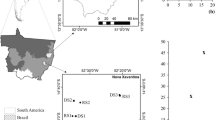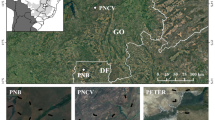Abstract
The relationship between the floristic composition of communities and the underlying environmental and spatial determinants is still the subject of intense debate, mainly because only recently has geographical distance been cited as an important driver of plant communities. We analysed environmental (elevation, climate and soil properties [E]) and spatial (geographic distance [S]) effects on the floristic composition of savannas on different substrates, one on a steep relief with shallow and rocky soils, and the other on flat terrain with deep soils. We show that: (1) savannas on rocky soils soils contain more nutrients, are more acidic and have a finer texture than savannas on deep soils; (2) that the dissimilarity between the rocky soils and deep soils is associated mainly with variation in altitude and soil properties and (3) that the individual and combined contributions of the environment and space to the floristic composition of woody plants differs between savannas on deep and rocky soils. Spatially structured environmental variation [E] + [S] explained 29% of the floristic composition variation in savannas on rocky soils and 41% in savannas on deep soils. In the rocky soils, the pure fraction explained by the [E] was larger (10%) than that recorded for deep soils (4%), but the pure effect of space [S] explained 2 and 3% of the variation on rocky and deep soils, respectively. The environmental variables analysed here are therefore strongly structured in space on both rocky and deep soils, but the total and combined environmental and spatial effects are larger in savannas on deep soils than in those on rocky soils.




Similar content being viewed by others
References
Abadia AC, Lenza E, Mews HA, Maracahipes-Santos L, Winck N, Pessoa MJG (2018) Savannas on two different substrates in Brazil have a similar species diversity, but distinct edaphic conditions and species composition. Brazil J Bot 41:57–64
Alvares CA, Stape JL, Sentelhas PC, Moraes G, Leonardo J, Sparovek G. (2013) Köppen's climate classification map for Brazil. Meteorol Z 22:711–728
APG IV (2016) An update of the Angiosperm Phylogeny Group classification for the orders and families of flowering plants: APG IV. Bot J Linn Soc 181:1–20
Benites VM, Schaefer CEGR, Simas FNB, Santos HG (2007) Soils associated with rock outcrops in the Brazilian mountain ranges Mantiqueira and Espinhaço. Rev Brasil Bot 30:569–577
Bivand RS, Hauke J, Kossowski T (2013) Computing the Jacobian in Gaussian spatial autoregressive models: an illustrated comparison of available methods. Geogr Analysis 45:150–179
Blanchet G, Legendre P, Borcard D (2008) Forward selection of spatial explanatory variables. Ecology 89:2623–2632
Borcard D, Gillet F, Legendre P (2011) Numerical ecology with R. New York
Collinson AS (1988) Tropical formations with conspicuous grasslands: savannas. In Collinson AS (ed.) Introduction to world vegetation. Unwin Hyman Ltd, London, pp 232–248
Dray S (2013) spacemakeR: spatial modelling. In R Package version 0.0-5/r113. Available at http://r-forge.r-project.org/projects/sedar
Dray S, Dufour AB (2007) The ade4 package: implementing the duality diagram for ecologists. J Stat Softw 22:1–20
Dray S, Pélissier R, Couteron P, Fortin M-J, Legendre P, Peres-Neto PR, Bellier E, Bivand R, Blanchet FG, De Cáceres M, Dufour A-B, Heegaard E, Jombart T, Munoz F, Oksanen J, Thioulouse J, Wagner HH (2012) Community ecology in the age of multivariate multiscale spatial analysis. Ecol Monogr 82:257–275
Dray S, Legendre P, Blanchet G (2013) packfor: forward selection with permutation. R Package version 0.0-8/r109. Available at https://rdrr.io/rforge/packfor
Embrapa (2006) Sistema brasileiro de classificação de solos. 2a edição. Rio de Janeiro
Gazol A, Ibáñez R (2010) Variation of plant diversity in a temperate unmanaged forest in northern Spain: behind the environmental and spatial explanation. Pl Ecol 207:1–11
Giraudoux P (2015) pgirmess: data analysis in ecology. R Package version 1.6.2. Available at http://cran.r-project.org/package=pgirmess
Goodland R, Pollard R (1973) The Brazilian Cerrado vegetation: a fertility gradient. J Ecol 61:219–224
Haridasan M (2000) Nutrição mineral das plantas nativas do Cerrado. Revista Brasil Fisiol Veg 12:68–83
Jones MM, Ferrier S, Condit R, Manion G, Aguilar S, Pérez R (2013) Strong congruence in tree and fern community turnover in response to soils and climate in central Panama. J Ecol 101:506–516
Legendre P, Gallagher ED (2001) Ecologically meaningful transformations for ordination of species data. Oecologia 129:271–280
Legendre P, Dale MRT, Fortin M, Gurevitch J, Hohn M, Myers D (2002) The consequences of spatial structure for the design and analysis of ecological field surveys. Ecography 5:601–615
Legendre P, Borcard D, Roberts DW (2012) Variation partitioning involving orthogonal spatial eigenfunction submodels. Ecology 93:1234–1240
Maracahipes-Santos L, Lenza E, dos Santos JO, Marimon BS, Eisenlohr PV, Marimon Junior BH, Feldpausch TR (2015) Diversity, floristic composition, and structure of the woody vegetation of the Cerrado in the Cerrado – Amazon transition zone in Mato Grosso, Brazil. Brazil J Bot 38:877–887
Marimon Junior BH, Haridasan M (2005) Comparação da vegetação arbórea e características edáficas de um cerradão e um cerrado sensu stricto em áreas adjacentes sobre solo distrófico no leste de Mato Grosso, Brasil. Acta Bot Brasil 19:913–926
McIntire EJB, Fajardo A (2009) Beyond description: the active and effective way to infer processes from spatial patterns. Ecology 90:46–56
Mendonça RC, Felfili JM, Walter BT, Silva Junior MC, Rezende AV, Filgueiras TS, Nogueira PE, Fagg CW (2008) Flora Vascular do bioma Cerrado: checklist com 12.356 espécies. In Sano SM, Almeida SP, Ribeiro JF (eds) Cerrado: ecologia e flora. Embrapa-CPAC, Planaltina, pp 421–1279
Messias MCTB, Leite MGP, Meira Neto JAA, Kozovits AR, Tavares R (2013) Soil-vegetation relationship in quartzitic and ferruginous Brazilian rocky outcrops. Folia Geobot 48:509–521
Mews HA, Pinto JRR, Eisenlohr PV, Lenza E (2014) Does size matter? Conservation implications of differing woody population sizes with equivalent occurrence and diversity of species for threatened savanna habitats. Biodivers & Conservation 23:1119–1131
Mews HA, Pinto JRR, Eisenlohr PV, Lenza E (2016) No evidence of intrinsic spatial processes driving neotropical savanna vegetation on different substrates. Biotropica 48:433–442
Moeslund JE, Arge L, Bøcher PK, Dalgaard T, Svenning JH (2013) Topography as a driver of local terrestrial vascular plant diversity patterns. Nordic J Bot 31:129–144
Motta PEF, Carvalho-Filho A, Ker JC, Pereira NR, Carvalho Junior W, Blancaneaux P (2002) Relações solo-superfície geomórfica e evolução da paisagem em uma área do Planalto Central Brasileiro. Pesq Agropecu Brasil 37:869–878
Oksanen J, Blanchet FG, Friendly M, Kindt R, Legendre P, McGlinn D, Minchin PR, O'Hara RB, Simpson GL, Solymos P, Stevens MHH, Szoecs E, Wagner H (2017) vegan: community ecology package. R package version 2.4-3. Available at https://CRAN.R-project.org/package=vegan
Oliveira-Filho AT, Enivanis AV, Carvalho DA, Gavilanes ML (1994) Effects of soils and topography on the distribuiton of tree species in a tropical riverine forest in south-eastern Brazil. J Trop Ecol 10:483–508
Peres-Neto PR, Legendre P, Dray S, Borcard D (2006) Variation partitioning of species data matrices: estimation and comparison of fractions. Ecology 87:2614–2625
Peres-Neto PR, Legendre P (2010) Estimating and controlling for spatial structure in the study of ecological communities. Global Ecol Biogeogr 19:174–184
R Core Team (2017) R: a language and environment for Statistical Computing. R Found. Stat. Comput. Vienna, Austria
Renka RJ, Eglen S, Zuyev S, White D (2015) tripack: triangulation of irregularly spaced data. R Package version 1.3-7. Available at http://cran.rproject.org/package=tripack
Ribeiro JF, Walter BMT (2008) As principais fitofisionomias do bioma Cerrado. In Sano SM, Almeida SP, Ribeiro JF (eds) Cerrado: ecologia e flora. Embrapa-CPAC, Planaltina, pp 151–212
Rossatto DR, Ramos Silva LC, Villalobos-Vega R, Sternberg LSL, Franco AC (2012) Depth of water uptake in woody plants relates to groundwater level and vegetation structure along a topographic gradient in a neotropical savanna. Environm Exp Bot 77:259–266
Ruggiero PGC, Batalha MA, Pivello VR, Meirelles ST (2002) Soil-vegetation relationships in Cerrado (Brazilian savanna) and semideciduous forest, Southeastern Brazil. Pl Ecol 160:1–16
Sankaran M, Ratnam J, Hanan N (2008) Woody cover in African savannas: the role of resources, fire and herbivory. Global Ecol Biogeogr 17:236–245
Santos TRR, Pinto JRR, Lenza E (2012) Floristic relationships of the woody component in rocky outcrops savanna areas in Central Brazil. Flora 207:541–550
Silva JMC, Bates JM (2002) Biogeographic Patterns And Conservation In The South American Cerrado: A Tropical Savanna Hotspot. Bioscience 52:225–234
Silva JF, Fariñas MR, Felfili JM, Klink CA (2006) Spatial heterogeneity, land use and conservation in the Cerrado region of Brazil. J Biogeogr 33:536–548
Simon MF, Proença C (2000) Phytogeographic patterns of Mimosa (Mimosoideae, Leguminosae) in the Cerrado biome of Brazil: an indicator genus of high-altitude centers of endemism? Biol & Conservation 96:279–296
Stokes CJ, Archer SR (2010) Niche differentiation and neutral theory: an integrated perspective on shrub assemblages in a parkland savanna. Ecology 91:1152–1162
Wilkinson L (2011) venneuler: Venn and Euler diagrams. R Package version 1.1-0. Available at http://cran.r-project.org/package=venneuler
Acknowledgements
We are grateful to the Coordenação de Aperfeiçoamento de Pessoal de Nível Superior (CAPES) for the concession of a graduate scholarship and financial support through the PROCAD UnB/UNEMAT project (Proc. 88881.068430-2014-01). We also thank the Conselho Nacional de Desenvolvimento Científico e Tecnológico (CNPq) for financial support through the SISBIOTA (Proc. 563320-2010-9), PPBio Cerrado (Proc. 457587-2012), PELD-TRAN (Proc. 558069/2009-6) and ‘Phytogeography, diversity and functional traits of woody vegetation in savannas of Serra do Roncador, Mato Grosso east: soil and spatial influences and implications for conservation’ (Proc. 447542/2014-1) projects. We are also grateful to the TROBIT (Tropical Biomes in Transition – Long-Term Ecological Studies) for financial support. We thank Thiago Bernardi Vieira for his assistance with the statistical analyses.
Author information
Authors and Affiliations
Corresponding author
Rights and permissions
About this article
Cite this article
Abadia, A.C., Mews, H.A., Maracahipes-Santos, L. et al. The intrinsic effects of environment and space on the composition of woody plant species vary between Brazilian savannas growing on distinct types of substrate. Folia Geobot 53, 377–387 (2018). https://doi.org/10.1007/s12224-018-9327-2
Received:
Accepted:
Published:
Issue Date:
DOI: https://doi.org/10.1007/s12224-018-9327-2




